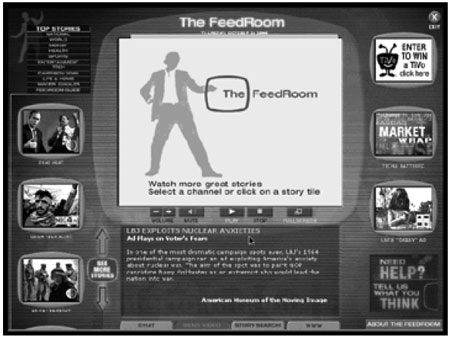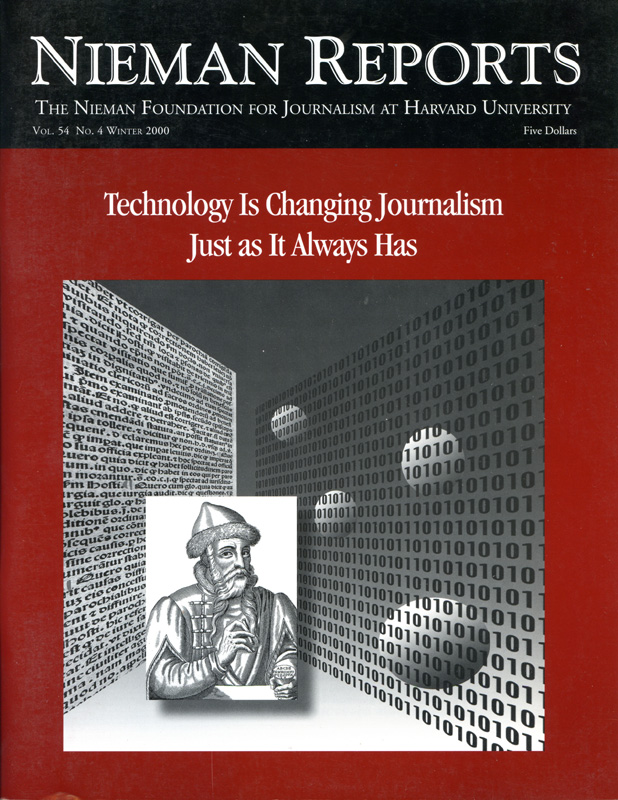
Some of my best journalist friends think I’ve become a threat to democracy. This is not some paranoid rant—The New York Times found the accusation fit to print. Others have expressed their concern privately.
It’s all because, after 16 years as a producer and executive at CBS News, I have just launched a broadband news network, The FeedRoom, backed by a $30 million investment from NBC, Tribune Company, and Warburg Pincus. The FeedRoom aggregates the latest news video from NBC and Tribune’s local television stations, among others, from wholesalers like Reuters and The Associated Press, and from a wide range of print entities that are beginning to broaden their offerings into multimedia, such as USA Today, Good Housekeeping, and Consumer Reports. Viewers with high-speed Internet connections can browse a menu of thumbnail-size still photos; click on the photo and the corresponding video begins to play on a large central screen along with associated text and Web links to more information.
As I understand the argument, the threat to the body politic arises from the fact that in The FeedRoom, ordinary citizens—not professional journalists—decide what news they will watch and, more ominously, what they will not watch. My sister could spend half an hour immersed in the latest crisis from the set of “Friends” while completely missing news about the latest crisis in the Middle East. My mother could follow every implant, transplant and bypass story in our Health channel, but accidentally bypass what the new Congress intends to do about Medicare. The citizenry, swept up by a blizzard of choice, becomes woefully misinformed about the real issues with which they must grapple as active participants in a deliberative democracy.
That’s a disturbing prospect, especially to someone like me, whose devotion to democracy was amply demonstrated as far back as the 11th grade, when I was voted out as class president and peacefully handed over the reins of power. But The FeedRoom did not invent viewer choice: We’re simply embracing it as the most significant trend in communications over the past 20 years. We did not invent the high-speed broadband Internet, either—we’re simply using its fat pipes to bring television news to the computer.
We’ve learned that viewer choice leads to less dumbing down and more depth than television producers have chosen to offer in a long while. On the day I write this, The FeedRoom’s Campaign 2000 channel offers 21 different election-related news videos from 10 different mainstream sources, as well as related wire copy and links to campaign Web sites. Broadband offers my television brethren, perplexed to the point of paralysis by eroding audiences and increasing marginality, an invitation to the interactive party that has been closed to them so far. All they have to do is R.S.V.P.
It turns out that broadcast television was the Alexander Kerensky of the communications revolution, brushed aside by the Bolsheviks of cable and the Web. Two decades ago, Ted Turner made news available any time, raising the bar beyond broadcasters’ reach. Then, even more significantly, Steve Case made information available anywhere—even on your desk at work—and Americans had literally millions of different information sources at their command online.
Internet One, as we’ll call the narrowband, slow-speed, text-intensive Web that exploded in popularity during the past six years, favored stodgy print providers like wire services and newspapers, eager to reuse the oceans of ink their core businesses pump out every day. The indexers of this ink—the Yahoo!’s and AOL’s—did even better. In this environment, television suddenly found itself the stodgy one; stations’ Web sites offered pitifully little content compared to information-laden print outlets, and online users, more mercilessly results-oriented than General Electric’s CEO Jack Welch, ignored them.
According to the latest Pew study of American news habits, the number of Americans who go online for news every day has risen nine percent during the past two years. But more of that audience goes to the online wire services of Yahoo! or AOL News than to all of the branded television providers’ sites (CNN.com, ABCNews.com, MSNBC.com, et al.) combined, and local newspaper sites outdraw local television sites two to one. Meanwhile, Pew reports, during that same two-year period network and local television news viewing dropped six percent, with the youngest and best educated viewers deserting in droves for online news.
But Internet Two has now squealed to the curb—a video-rich, multimedia roadster to Internet One’s Model T—and television news organizations have a chance to hop on board and leave the competition’s jalopies in the dust by offering “television, only better” to the 38 million broadband viewers whose ranks are growing by 500,000 per month. Given the high quality of video streaming available today—between two and 10 times faster than the herky-jerky nickelodeon shows of narrowband—the stage is set for television news over the home computer.
Broadband viewers want news, according to a new study by McKinsey & Company that compared narrowband and broadband user behavior. News and information sites show the largest gains among broadband users of any type of online site; perhaps because broadband connections are always on, like a dial tone, they are ideally suited for the constant updating of information. Jupiter Communications has found that among the millions of online users who stream video, news is even more popular than entertainment or sports video, and news sites encourage the longest visits of any category.
The FeedRoom enables the 35 television stations in our network—which belong to NBC, Tribune Company, Granite Broadcasting, and Journal Broadcasting—to offer 24-hour news coverage over the computer, via cobranded local FeedRooms. In addition, the national www.feedroom.com site aggregates all of the local stories as well as a slate of national content. Viewers watch the latest news video presented on an atomic level; that is, the individual one-minute-30 news segments that comprise a newscast made accessible in any order they wish. As one viewer put it, “This is like television that I control.”
The advantages of choice are apparent upon arrival. Say you’re looking for the weather report, one of the main drivers of local news viewership. On television you have to wait 13 minutes for the weather segment and then you’ve got to sit through all kinds of computer-generated legerdemain to get to what you really want to know: what to wear tomorrow morning. In your local FeedRoom, you can click right away on the five-day forecast thumbnail and play only that part of the weather segment that interests you, delivered by an on-air personality you have come to trust. Narrowband users click an icon and get weather data; broadband viewers can click and get Al Roker, all day.
What’s more, viewer control turns passive viewers into active participants. How many times have you walked into the office on Monday morning and asked a coworker, “Did you see that story on ‘60 Minutes’ last night?” In broadband, you could actually discuss that story with others who have watched it, drill for more information on the subject, send a clip of the story to a friend, or even watch unaired portions that were left on the cutting room floor. “60 Minutes” could stretch for endless hours, as your immersion in the subject matter grows deeper and more rewarding. That kind of multidimensional experience would be good for news divisions and good for their viewers (and good for democracy, for that matter).
The FeedRoom’s technology engine allows the most precise knowledge of news viewer habits and interests ever obtained. The video database that powers The FeedRoom records every click every viewer makes—anonymously, unless they want to volunteer their name or e-mail address in order to receive customized traffic reports or news updates. We’ll know that Viewer 3675Sigma goes right for the sports channel every time, calling up every new Yankee story; then she scans the Money channel followed by the latest movie review. We can make sure that 3675 gets her fix every time by presenting those stories upon her arrival, making it more likely that she will return. And every time she does, her visit will begin with a quick set of headlines culled from the day’s top stories, as determined by our editorial staff of 40 former television, radio, print and online journalists. We have not surrendered editorial judgment—but we have stopped creating a “lineup,” because each viewer creates her own, choosing a unique path through the thicket of video generated by the world’s most dogged journalists.
In fact, despite all that choice, or perhaps because of it, our viewers tell us that they still want an editor. There’s just too much information flying around out there for any one individual to make sense of it all. They’re too busy to cull through the myriad satellite feeds beaming this way and that; they couldn’t possibly take the time to link video to text or to hunt down related Web sites. Our viewers want to make the final choice as to what they watch, but not the initial choice. They want more options—not infinite options. Yahoo! made a mint—and made itself an indispensable information source—by making sense of the Web; now television news organizations can do the same by making sense of the world once again for a new generation of viewers.
And there is money to be made in doing so. The same targeting technology that lets you create your own 24-hour news channel can also inform you of products you are most interested in buying. That type of targeting is worth a lot more to advertisers than banner ads that everyone ignores, which is why the FeedRoom sales team is seeing broadband advertising rate as high as $100 per thousand viewers, compared to the $15-25 norm for television and five dollars or less for banners. As broadband penetration continues to soar—it has more than tripled in 2000 alone—news departments will generate revenue several times over from the same piece of news footage. Because media companies own more of their news footage outright than they do other forms of content, news divisions can become much more significant corporate players in the digital world.
The FeedRoom is constantly called on by the builders of tomorrow’s delivery platforms—set-top box, wireless, terrestrial digital, wired homes—all of whom are hungry for content. News departments are content factories and will be in a position to dictate the terms of sale. Certainly, there is a danger that commerce and editorial content could become confused by viewers or commingled by overreaching sales executives, especially because online viewers tend not to be offended by advertising residing nearby editorial content. That calls for extra vigilance by the managers of broadband news sites.
Fragmentation has been a fact of American life throughout our history. The idea that there was ever one monolithic American audience engaged in an ongoing national conversation is comforting but inaccurate; even during the Washington Administration, Democrat-Republicans read one pamphleteer and Federalists another, and most people simply pulled a plow, oblivious to it all. There have always been as many audiences as there are audience members, a reality that FM radio and then cable television and ultimately the Internet were nimble enough to exploit but that broadcast television could not—until today.
Give up trying to inform everyone about everything and you begin informing more people about the truly important things—important as defined by them. Address each viewer’s individual interests and needs and be freed from the guesswork that leads to silly sweeps series and Sansabelt newscasts—one-size-fits-all.
Heed the inner voice whispering that television news is no longer quite the calling you thought it would be right out of journalism school. The audience is calling from the other side of the digital divide. Respond, please.
Jonathan Klein founded The FeedRoom in September 1999, following an award-winning 16-year career at CBS News, where he was executive vice president (1996-1998) and for many years worked as executive producer, producer, director, creator and documentary filmmaker on a variety of news shows.



